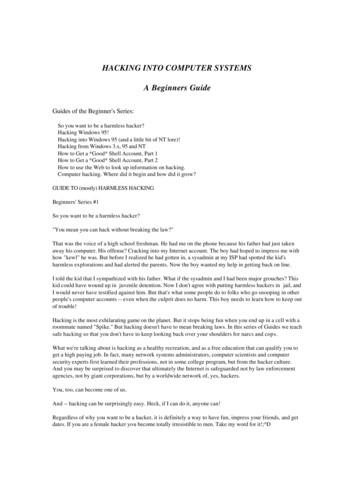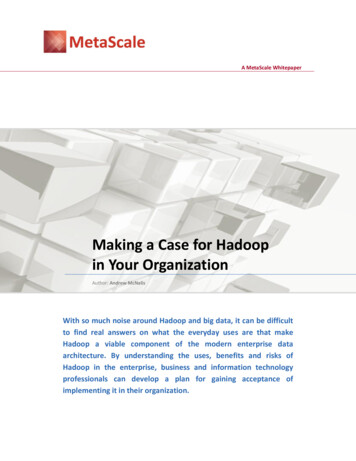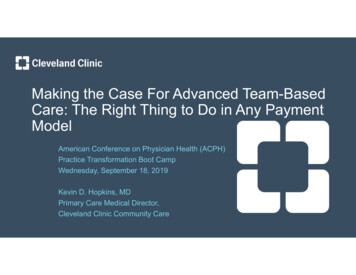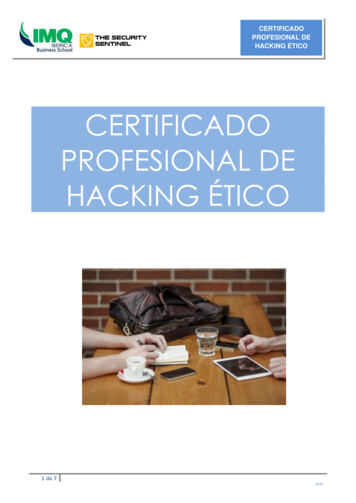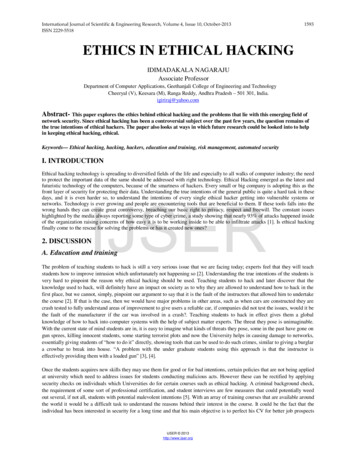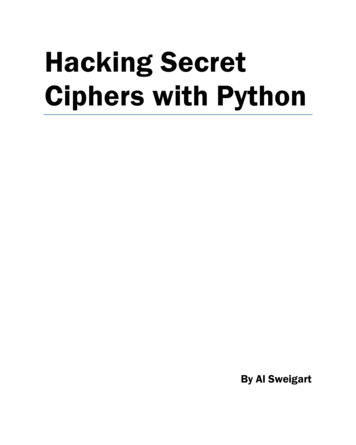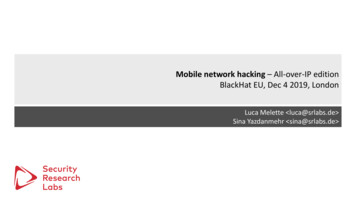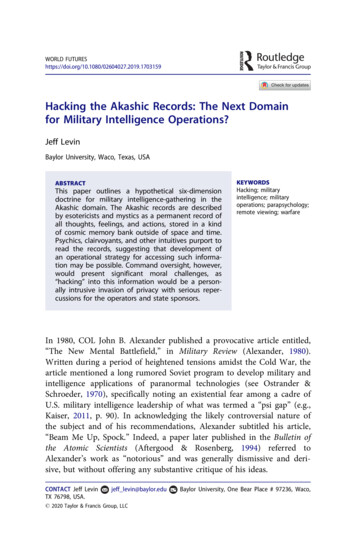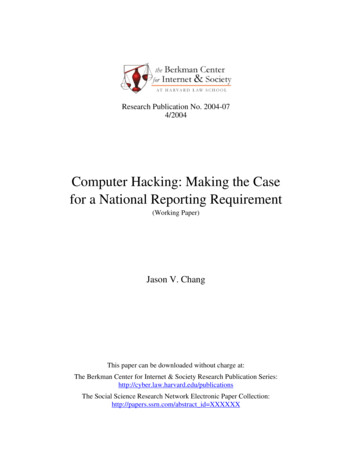
Transcription
Research Publication No. 2004-074/2004Computer Hacking: Making the Casefor a National Reporting Requirement(Working Paper)Jason V. ChangThis paper can be downloaded without charge at:The Berkman Center for Internet & Society Research Publication e Social Science Research Network Electronic Paper Collection:http://papers.ssrn.com/abstract id XXXXXX
JEL Classification: K20, K42, O33, O38COMPUTER HACKING: MAKING THE CASE FOR A NATIONALREPORTING REQUIREMENTJason V. Chang ABSTRACTThe incidences of computer hacking have increased dramatically overthe years. Indeed, the current federal laws, including the Computer Fraud andAbuse Act, have done very little to deter potential computer hackers. Thisarticle finds that only a small percentage of computer hackers are ever caughtand prosecuted. The biggest problem is that most victimized companiesregrettably choose to hide the problem from the public due in part to negativepublicity concerns. As a result, this article proposes that a mandatory reportingrequirement imposed by Congress, which forces companies to discloseintrusions, will be salient to the problem of computer hacking in severalregards. First, individuals who are affected by the intrusions will receiveadvance warning that their personal information was stolen by hackers. Thiswill allow these affected individuals to take precautions in securing theiridentities. Secondly, the mandatory reportings will assist law enforcement ininvestigating and prosecuting a greater percentage of computer hackers. Asmore prosecutions of computer hackers are publicized, this should reduce thefuture incidences of computer hackings. Moreover, on July 1, 2003, Californiabecame the first state to enact a reporting requirement for computer hackings.This could provoke other states to pass similar reporting requirements. Becausecomputer hacking is a national (and international) problem, Congress needs toconsider enacting a reporting requirement before an untenable piecemeal stateby-state solution occurs.Keywords: computer, hacking, hacker, intrusion, software security,cybercrime, identity theftJ.D. Candidate, 2004, Harvard Law School; B.S. Electrical Engineering, 2001, GeorgiaInstitute of Technology. I wish to acknowledge the support and guidance of Professor JohnPalfrey of the Berkman Center for Internet & Society at Harvard Law School.
COMPUTER HACKING: MAKING THE CASE FOR ANATIONAL REPORTING REQUIREMENTJason V. ChangTable of ContentsI. Introduction 1II. Current Federal Lawsagainst ComputerHacking 3III. Failures PreventingReduction in IntrusiveComputer Hacking 8IV. Moving Towards aNational ReportingRequirement forComputer Intrusions 17V. Benefits of theProposed ReportingRequirement 27VI. Critique of theProposed ReportingRequirement 32VII. Conclusion 34Appendix 35
COMPUTER HACKING: MAKING THE CASE FOR ANATIONAL REPORTING REQUIREMENT Jason V. Chang 2004 (Working Paper).**I.INTRODUCTIONComputer hackings have grown at an alarming rate and the effects arewidespread and costly. Each year hackers steal millions of dollars worth ofproprietary information from companies and organizations. A survey by theComputer Security Institute indicated that for the year 2002, theft of proprietaryinformation by hackers cost companies and organizations over 70 million.1 Thecost to insure against these hackers is staggering— the market for hackerinsurance is expected to increase from 100 million in 2003 to 900 million by2005.2 In addition, hackers can cause severe damage to computer systems byaltering or deleting data files and disabling software.In addition to proprietary information, hackers also steal personalinformation from these organizations and corporations including their customers’credit card numbers, account numbers, and social security numbers. For example,in 2000, hackers stole 55,000 credit card numbers from creditcards.com and300,000 credit card numbers from CDUniverse.com.3 The theft of personalinformation such as credit card numbers raises serious concerns relating to bothidentity theft and privacy.**Permission is granted to use this work under the Creative Commons Attribution License,available at TER SECURITY INSTITUTE, CSI/FBI COMPUTER CRIME AND SECURITY SURVEY 20(2003), available at http://www.security.fsu.edu/docs/FBI2003.pdf. The respondents to thissurvey included 17% from high-tech companies, 15% from the financial sector, and 15% fromgovernment agencies. Id. at 2. Further, more than half of the organizations taking part in thesurvey had more than 1,000 employees while approximately 28% had more than 10,000employees. Id. at 3.2Jon Swartz, Firms’ hacking-related insurance costs soar, USA TODAY, Feb. 9, 2003,available at y/2003-02-09-hacker x.htm.Worse yet, many general-liability policies have now eliminated the hacking-related portion of thecoverage because of the number of claims filed within the last two years. See id. Thus,companies are being forced to choose between paying 5,000 to 30,000 a year for 1 million instand-alone hacking coverage or not being insured against hackers at all. See id.3Associated Press, Extortionist Puts Credit Card Data on Web, CBSNEWS.COM, Dec.14, 2000, at technology/main257200.shtml.In the creditcard.com incident, the hackers who stole the credit card numbers demanded 100,000ransom. Id. When the extortion payment was not made, the hackers retaliated by posting thestolen credit card numbers on a public webpage. Id.1
Even more disconcerting than the theft of proprietary and personalinformation is the fact that most companies and organizations are not reportinghacking incidents to law enforcement.4 According to surveys from 1999 to 2003,only about 30% of hacking intrusions are ever reported.5 Further, Internettechnology presents high hurdles for law enforcement to trace the hackingintrusions back to the hacker. This means that the vast majority of hackers havevery little chance of being caught and prosecuted.Because tackling the area of computer hacking requires an understandingof the technical issues involved, an Appendix is included, which will introducethe numerous tools that hackers use to accomplish their intrusive hacking attacks.Knowledge of this is necessary to appreciate the applicability of the current lawsto these tools. Some readers may find it helpful to reference the Appendix beforebeginning Part II of the paper, which covers the scope of several federal lawscommonly used against hackers.Part III of the paper will evaluate the technical, societal, and legal failuresthat result in hackers not being caught or prosecuted. Against this background,Part IV of this paper proposes a national reporting requirement to tackle theproblem of computer intrusions with respect to the computer networks oforganizations and corporations. The national reporting requirement frameworkwill propose one set of reporting requirements when privacy is at stake andanother set of reporting requirements aimed at deterring property damage byhackers. Part V will then illustrate how such a framework for a national reportingrequirement could help bridge the current technical, societal, and legalshortcomings discussed in Part III and thus reduce the number of computerintrusions in business and organizational computer networks as a whole. Finally,Part VI anticipates and responds to several major arguments against a reportingrequirement.While there is also the problem of hacking into personal computers, thispaper does not intend to address that problem. However, as will be discussed inPart III of the paper, many hackers take control of personal computers for thepurpose of launching hacking attacks on corporate computers. Accordingly, it isconceivable that reducing the number of corporate and organizational hackingintrusions will result in a proportionate decline in the number of personalcomputers attacked.45See COMPUTER SECURITY INSTITUTE, supra note 1, at 17.See id.2
II.CURRENT FEDERAL LAWS AGAINST COMPUTER HACKINGThis section covers the federal approaches applicable to computer crimesthat may be relevant to the problem of computer hacking. The author realizes thatsome states may have their own laws tailored toward various computer crimes,like the variations of the proposed Federal Computer Systems Protection Act.6Further, many practitioners have been creative in applying common lawapproaches along with other state laws (such as trade secrets law) to the area ofcybercrime.7 However, because of the numerous jurisdictional limitations ofstate laws8 and because computer hacking is not limited by state borders, thispaper focuses on the two main federal laws relevant to computer hacking—theElectronic Communications Privacy Act and the Computer Fraud and Abuse Act.A.Electronic Communications Privacy ActThe Electronic Communications Privacy Act of 1986 (“ECPA”) wasCongress’s patchwork attempt to fit new crimes into the existing laws.9 Title I ofthe ECPA amended the Federal Wiretap Act, 18 U.S.C. §§ 2510 et al., to includenot only wire or oral communications, but also electronic communications.10Title II of the ECPA created the Stored Communications Act.11 The coverage ofboth the Federal Wiretap Act and the Stored Communications Act is describedbelow.1.Federal Wiretap Act, 18 U.S.C. §§ 2510 et al.Title I of the ECPA amended the Federal Wiretap Act to cover not onlywire and oral communications, but also electronic communications.12 The current6See, e.g., the Georgia Computer Systems Protection Act at O.C.G.A. § 16-9-90 (2002).As an example, in Ebay, Inc. v. Bidder’s Edge, Inc., Bidder’s Edge, an auctionaggregation site, used an unauthorized robot to collect auction listings from eBay’s site. See 100F. Supp. 2d 1058, 1062-63 (N.D. Cal. 2000). Based on eBay’s claim that Bidder’s Edge’sactivities constituted trespass to chattels, the court granted a preliminary injunction againstBidder’s Edge’s use of robots to collect information from eBay’s site. See id. at 1072.8The author also realizes that computer hackings often originate from foreigncountries—China is one such example. See, e.g., Daniel M. Creekman, Comment, A HelplessAmerica? An Examination of the Legal Options Available to the United States in Response toVarying Types of Cyber-Attacks from China, 17 Am. U. Int’l Rev. 641, 675 (2002) (stating that the“lack of an agreement with China, whether a bilateral extradition treaty or a multilateralinternational agreement, prevents an action to seek legal redress from a lone Chinese citizenhacker, regardless of the importance of the victimized computer system.”). This raisesinternational jurisdictional issues that, while important in certain circumstances, are beyond thescope of this undertaking.9See Konop v. Hawaiian Airlines, Inc., 302 F.3d 868, 874 (stating that the “existingstatutory framework is ill-suited to address modern forms of communications”).10See id. (reviewing S. Rep. No. 99-541, at 3 (1986)).11See id.12See id. (stating that the Wiretap Act was amended to “address[] the interception of . . .electronic communications”). Congress gave “electronic communications” an expansivedefinition. An electronic communication is “any transfer of signs, signals, writing, images,73
version of the Wiretap Act prohibits intentionally intercepting (or endeavoring tointercept) any wire, oral, or electronic communication.13 In addition, the WiretapAct punishes disclosing or using the contents of any wire, oral, or electroniccommunication with knowledge that the information was obtained through theprohibited interception of a wire, oral, or electronic communication.14A large blow to the effectiveness of the Wiretap Act against computerhackers was the judicially-interpreted requirement of an “acquisitioncontemporaneous with transmission.”15 This means that hackers that obtaininformation through their intrusive attacks do not violate the Wiretap Act unlessthey capture the information while it is being transmitted from one computer toanother.16 Presumably, the Wiretap Act applies to hackers who install networkpacket sniffers (“sniffers”) to intercept real-time communications. This isbecause sniffers capture network data packets while they are in transmission, andthus the acquisitions of the data packets by the sniffers are contemporaneous withtheir transmission from one computer to another. Unfortunately, the case law isabsolutely devoid of examples of prosecutions in such cases.sounds, data, or intelligence of any nature transmitted in whole or in part by a wire, radio,electromagnetic, photoelectronic or photooptical system that affects interstate or foreigncommerce, but does not include-- (A) any wire or oral communication . . . .” 18 U.S.C. §2510(12).13See 18 U.S.C. § 2511(1)(a) (prohibiting “intentionally intercept[ing], endeavor[ing] tointercept, or procur[ing] any other person to intercept or endeavor to intercept, any wire, oral, orelectronic communication”). A violation of 18 U.S.C. § 2511(1) may result in a fine orimprisonment for not more than five years, or both. See 18 U.S.C. § 2511(4). Notwithstandingpossible criminal punishment, the Wiretap Act generally authorizes recovery of civil damages.See 18 U.S.C. § 2520(a) (stating that “any person whose wire, oral, or electronic communication isintercepted, disclosed, or intentionally used in violation of this chapter . . . may in a civil actionrecover from the person or entity . . . which engaged in that violation such relief as may beappropriate”).14See 18 U.S.C. § 2511(1)(c) (prohibiting “intentionally disclos[ing], or endeavor[ing] todisclose, to any other person the contents of any wire, oral, or electronic communication, knowingor having reason to know that the information was obtained through the interception of a wire,oral, or electronic communication in violation of this subsection”); 18 U.S.C. § 2511(1)(d)(prohibiting “intentionally us[ing], or endeavor[ing] to use, the contents of any wire, oral, orelectronic communication, knowing or having reason to know that the information was obtainedthrough the interception of a wire, oral, or electronic communication in violation of thissubsection”).15The word “intercept” as used in the Wiretap Act has been interpreted to mean an“acquisition contemporaneous with transmission.” See U.S. v. Steiger, 318 F.3d 1039, 1048 (11thCir. 2003), cert. denied, 123 S. Ct. 2120 (2003). The Fifth, Ninth, and Eleventh Circuit have allrequired such an interpretation of the word “intercept.” See Theofel v. Farey-Jones, 341 F.3d 978,986 (9th Cir. 2003); Steiger, 318 F.3d at 1048; Konop v. Hawaiian Airlines, Inc., 302 F.3d 868,878-89 (9th Cir. 2002) (withdrawing contrary panel opinion at 236 F.3d 1035 (9th Cir. 2001));Steve Jackson Games, Inc. v. U.S. Secret Serv., 36 F.3d 457, 460 (5th Cir. 1994).16See id.4
2.Stored Communications Act, 18 U.S.C. §§ 2701 et al.The Stored Communications Act (“SCA”) was created by Title II of theECPA. Title 18 U.S.C. § 2701(a) of the SCA punishes “whoever—(1)intentionally accesses without authorization a facility through which an electroniccommunication service is provided; or (2) intentionally exceeds an authorizationto access that facility; and thereby obtains, alters, or prevents authorized access towire or electronic communication while it is in electronic storage in such system . . .”1817The SCA only applies if the target of the attack is an “electroniccommunication service.”19 An electronic communication service is defined as“any service which provides to users thereof the ability to send or receive wirecommunications.”20 An email server would clearly fit this definition as wouldInternet Service Providers.21 However, courts have determined that personalcomputers are not electronic communication services within the purview of theSCA.22 Unfortunately, this means that if the hacker breaks into a computer that isnot a qualifying electronic communication service, then the SCA does not apply.This limitation has curbed the effectiveness of the SCA against computer hackers.B.Computer Fraud and Abuse Act (18 U.S.C. § 1030)1.OverviewTitle 18 U.S.C. § 1030, otherwise known as the Computer Fraud andAbuse Act (“CFAA”), is currently the most targeted and comprehensive federallaw directed towards computer-related criminal conduct. The premise behind theenactment of the CFAA was to “deter and punish those who intentionally access17See supra note 11.18 U.S.C. § 2701(a). Violations of the SCA may result both fines and imprisonment (ifoffense was for commercial advantage, malicious destruction or damage, or private commercialgain, or in furtherance of any criminal or tortuous act, then imprisonment for not more than 5years for first offenses or not more than 10 years for a subsequent offense). See 18 U.S.C. §2701(b). In addition, in certain circumstances, civil causes of action are authorized. See 18U.S.C. § 2707 (stating that “any provider of electronic communication service, subscriber, or otherperson aggrieved by any violation of the [Stored Communications Act] in which the conductconstituting the violation is engaged in with a knowing or intentional state of mind may, in a devilaction, recover from the person or entity . . . which engaged in that violation such relief as may beappropriate”).19See 18 U.S.C. § 2701(a).2018 U.S.C. § 2510(15) incorporated by 18 U.S.C. § 2711(1) (stating that “the termsdefined in section 2510 of this title have, respectively, the definitions given such terms in thatsection”).21See Theofel, 341 F.3d at 984-85 (finding that email stored at an Internet ServiceProvider is within the scope of the SCA); Steiger, 318 F.3d at 1049 (noting that “the SCA mayapply to the extent the source accessed and retrieved any information stored with [the] Internetservice provider”).22See Steiger, 318 F.3d at 1049 (stating that ordinarily a personal computer does notmeet the requirements of an electronic communication service).185
computer files and systems without authority and cause harm.”23 The CFAAcontains seven substantive provisions. Each of the seven provisions will beintroduced according to its statutory order.First, section 1030(a)(1) prohibits knowingly accessing a computerwithout authorization or exceeding authorization, thereby obtaining andsubsequently transferring classified government information.24Next, section 1030(a)(2), which is highly applicable to intrusive computerhackers, proscribes intentionally accessing a computer without authorization orexceeding authorization and obtaining information from a financial institution,any department or agency of the United States, or any protected computer25involved in interstate or foreign communication.26Section 1030(a)(3) makes it a crime to intentionally, withoutauthorization, access a nonpublic computer of a department or agency of theUnited States.27Section 1030(a)(4) prohibits knowingly and with intent to defraud,accessing a protected computer without authorization (or in excess ofauthorization) and thereby obtaining anything of value greater than 5,000 withinany 1-year period.28Section 1030(a)(5)(A) is the main anti-hacking provision and containsthree types of offenses. Subsection 1030(a)(5)(A)(i) proscribes knowinglycausing the transmission of a program, information, code, or command, and as aresult, intentionally causing damage without authorization to a protectedcomputer.29 Prior to the amendment by the USA PATRIOT Act of 2001(“PATRIOT Act”), the CFAA defined damage as “any impairment to the integrityor availability of data, a program, a system, or information that-- (A) causes loss23Doe v. Dartmouth-Hitchcock Med. Ctr., 2001 DNH 132 (D. N.H. 2001) (reviewing S.Rep. no. 104-357 (1996), pts. II, III).24See 18 U.S.C. § 1030(a)(1).25The definition of a “protected computer” is very inclusive. “[T]he term ‘protectedcomputer’ means a computer—(A) exclusively for the use of a financial institution or the UnitedStates Government, or in the case of a computer not exclusively for such use, used by or for afinancial institution or the United States Government and the conduct constituting the offenseaffects that use by or for the financial institution or the Government; or (B) which is used ininterstate or foreign commence or communication, including a computer located outside theUnited States that is used in a manner that affects interstate or foreign commerce orcommunication of the United States.” 18 U.S.C. § 1030(e)(2). It is not difficult to imagine thatmost computers connected to the Internet are involved in interstate commerce. Indeed, over 50million American computers that are connected to the Internet can be classified as “protectedcomputers.” See Mary M. Calkins, They Shoot Trojan Horses, Don’t They? An EconomicAnalysis of Anti-Hacking Regulatory Models, 89 Geo. L.J. 171, 172 (2000).26See 18 U.S.C. § 1030(a)(2).27See id. § 1030(a)(3).28See id. § 1030(a)(4).29See id. § 1030(a)(5)(A)(i).6
aggregating at least 5,000 in value during any 1-year period to one or moreindividuals.”30 Following the amendments by the PATRIOT Act, the CFAAeliminated the 5,000 jurisdictional requirement in criminal cases and damage isnow broadly defined as “any impairment to the integrity or availability of data, aprogram, a system or information.”31 While subsection 1030(a)(5)(A)(i) focusesmore on intentionally causing damage (without regard to authorization),subsection 1030(a)(5)(A)(ii) focuses on intentionally accessing a protectedcomputer without authorization.32 Subsection 1030(a)(5)(A)(ii) proscribesintentionally accessing a protected computer without authorization and therebyrecklessly causing damage. Finally, subsection 1030(a)(5)(A)(iii) proscribesintentionally accessing a protected computer without authorization and therebycausing damage.33Section 1030(a)(6) prohibits the trafficking of passwords through which acomputer may be accessed without authorization.34Finally, section 1030(a)(7) makes it a crime for someone to transmit acommunication in interstate or foreign commerce that threatens damage to aprotected computer for the intent of extorting money or other things of value.352.The CFAA as applied to intrusive computer hackersOf the seven prohibitions listed in the CFAA, two of these are particularlyimportant to the prosecution of intrusive computer hackers—namely sections1030(a)(2) and 1030(a)(5).As stated above, section 1030(a)(2) applies to a hacker who intentionallyaccesses a computer without authorization or exceeds authorization and obtainsinformation from a protected computer involved in interstate communication.36For example, a hacker may violate section 1030(a)(2) by obtaining unauthorizedaccess to an Internet computer through war dialing or through a Trojan horse37and then obtaining sensitive personal information such as social security numbersor credit card numbers from the hijacked computer.In addition, section 1030(a)(5) applies to a hacker that causes damage to aprotected computer. If the damage was caused by the transmission of a program,information, code, or command, then subsection 1030(a)(5)(A)(i) is applicable.3830Id. § 1030(e)(8) (1994 & Supp. IV 1998).Id. § 1030(e)(8).32See id. § 1030(a)(5)(A)(ii).33See id. § 1030(a)(5)(A)(iii).34See id. § 1030(a)(6).35See id. § 1030(a)(7).36See supra note 26 and accompanying text.37See parts C and E in the Appendix for discussions regarding war dialing and Trojan31horses.38See 18 U.S.C. § 1030(a)(5)(A)(i).7
Therefore, a Trojan horse (and also other viruses and worms) would be such a“program, information, code, or command” invoking the prohibition of subsection1030(a)(5)(A)(i). Alternatively, if the damage was caused from unauthorizedaccess, then either subsection 1030(a)(5)(A)(ii) or subsection 1030(a)(5)(A)(iii)would apply.39 Once the hacker obtains access to the computer, either through aTrojan horse or other unauthorized means such as war dialing or buffer overflowattacks,40 damage can result from altering or deleting existing files or otherwiseimpairing “the integrity or availability of data, a program, a system orinformation.”41A violation of any of the seven prohibitions of the CFAA can result incriminal sanctions.42 However, for civil damages, a violation of the CFAA mustinclude at least one of the five factors listed in section 1030(a)(5)(B).43 The mostrelevant of these five factors is the requirement of a “loss to 1 or more personsduring any 1-year period . . . aggregating at least 5,000 in value.”44 This oftenpresents a hurdle for victims who sometimes find it difficult to prove a loss of 5,000 in value.III.FAILURES PREVENTING REDUCTION IN INTRUSIVE COMPUTER HACKINGAs described in the Appendix, intrusive computer hackers have a varietyof tools available for them to breach the security of computer systems. Indeed,many hackers themselves freely share the tools and methods they have developedor acquired.45 Hackers, in addition, also utilize several additional tools to helpconceal their tracks. It is estimated that at most, only ten percent of successfulintrusions are ever detected.46 Even if an intrusion is successfully detected, arough estimate is that only between one and seventeen percent of these detectedintrusions are ever reported to law enforcement.47 Finally, of the successfulintrusions reported to law enforcement, only a small percentage of these cases are39See id. § 1030(a)(5)(A)(ii) and (iii).See part D of the Appendix for a discussion regarding buffer overflow attacks.4118 U.S.C. § 1030(e)(8).42See id. § 1030(c) (describing the punishments for violations of § 1030(a) or § 1030(b)).43See 18 U.S.C. § 1030(g) (stating that “[a] civil action for a violation of this section maybe brought only if the conduct involves 1 of the factors set forth in clause (i), (ii), (iii), (iv), or (v)of subsection (a)(5)(B)”).44See 18 U.S.C. § 1030(a)(5)(B)(i).45There is actually a hacker code of ethics that is generally followed by some in thehacking underground. Among these rules are to “always be willing to freely share and teach yourgained knowledge and methods” and to “respect knowledge and freedom of information.” SeeBrian Matheis, Hacker Ethics: Part II, Nov. 25, 2003, athttp://www.geocities.com/brian matheis/hacker ethics/part2.html (last visited Mar. 26, 2004).46See Jamila Harrison Vincent, Cyberterrorism, nvincent/ (last visited Mar. 26, 2004).47See id. However, these numbers are not beyond dispute. Surveys by the ComputerSecurity Institute have found that approximately 30% of its respondents have reported theirincidents to law enforcement. See supra note 5.408
successfully prosecuted.48 A 1999 study by David Banisar (“Banisar”), who wasinvolved with the Electronic Privacy Information Center, found that in 1998, ofthe 419 cases of computer fraud referred to federal prosecutors, only 83 caseswere prosecuted.49 Moreover, of these 83 cases, only 57 cases reacheddisposition— with 47 ending in convictions and the remaining 10 endingunsuccessfully for prosecutors.50 Surprisingly, the average sentence was only fivemonths and half of the defendants who were convicted received no jail time atall.51 Against this background, this paper will now discuss the technical, societal,and legal failures that contribute to the unsuccessful prosecution of computerhackers.A.Technical FailuresThe federal laws discussed in Part II— the ECPA and CFAA— are onlyeffective against computer hackers if they are apprehended. In this section, thevarious tools and methods that computer hackers use to conceal their activitiesand evade law enforcement will be discussed.1.Tracing difficultiesAll computers communicating on the Internet are assigned an InternetProtocol (“IP”) address.52 This IP address uniquely identifies a computer and issimilar to how a street address identifies a particular home.53 Because malicioushackers want to make it more difficult for law enforcement to find them, they willoftentimes mask their activities. These hackers may utilize intermediatecomputers, delete log files, or utilize anonymous proxy servers as describedbelow.a.Utilization of intermediate computersIf a hacker has compromised a computer, the hacker may utilize thiscompromised computer as a “launching pad” for attacks on other computers.54By launching their attacks from intermediate computers, computer hackers canmake it more difficult for law enforcement to trace their attacks.48See Kevin Poulsen, Study: Cybercime cases up 43 percent, ZDNET NEWS, Aug. 4,1999, at http://zdnet.com.com/2100-11-515355.html?legacy zdnn.49See id.50See id.51See id.52For a short and simple introduction on IP addresses, see Russ Smith, The IP Address:Your Internet Identity, CONSUMER.NET, Mar. 29, 1998, at http://consumer.net/IPpaper.asp.53See id.54See VERISIGN, INC., HACKING AND NETWORK DEFENSE 10 (2002), available er/vendor-wp/verisign/hacking.pdf (last visitedMar. 26, 2004) (stating that “[r]ather than use his or her own system to launch an attack, thehacker decides to use [the compromised computer]”).9
For example, the hacker can utilize compromised Computer A to connectto compromised Computer B, which is then used to attack the target computer. Inthis example, this means that law enforcement must penetrate two additionallayers of anonymity (Computers A and B) before discovering the hacker’scomputer.55As a first step, law enforcement will investigate the log file of the targetcomputer (and its Internet Service Provide (“ISP”)). The log file of the targetcomputer (or its ISP) will indicate the IP address of Computer B. Investigatorsmust then travel to Computer B and obtain its log file. The log fil
JEL Classification: K20, K42, O33, O38 COMPUTER HACKING: MAKING THE CASE FOR A NATIONAL REPORTING REQUIREMENT Jason V. Chang ABSTRACT The incidences of computer hacking have increased dramatically over the years. Indeed, t
